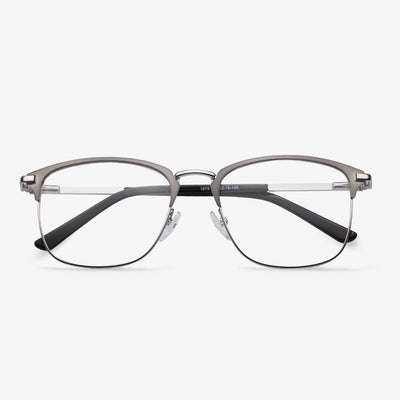What are the characteristics of a titanium frame?
The so-called pure titanium, titanium refers to the purity of more than 99% of the titanium metal materials. To tell if a pair of glasses frame is pure titanium, we look at its purity. Because of the high melting point of titanium, lightweight, strong corrosion-resistance, used for the frame, they can wear for a long time, and will not let the bridge of the nose have a sense of pressure. But its disadvantage is that the material is soft, and only the relatively rough frame lines are made to ensure the stability and strength of the frame. Titanium frame has the advantages of corrosion resistance, acid and alkali resistance, high stability, good elasticity, good toughness, not easy to deform and fade. General glasses frame contains copper, so when we wear for a long time .it will produce verdigris, namely, copper sulfate. It is a toxic substance and is harmful to the human body. Because pure titanium tends to be soft, copper has to be added to make the frames more stable, which is why the frames have to be replaced over time.
Do you need to wear glasses to drive?
In the evening, lights from street lamps, buildings, and other vehicles create a lot of reflection on the windshield, making it hard to see. It's even worse when it rains. But if your glasses have an anti-reflective coating, they can reduce the glare and reflections, allowing you to see more clearly while driving at night.
Why the lens coating is not uniform?
Sometimes we find differences in the color between the convex and concave surfaces, between the center and the edge of the lens, and the anti-reflection effect between the convex and concave surfaces. his is mainly because the lens coating is that it is plated on one surface and then turned over to another surface. And Areas with small curvature changes are easy to coat. So the center of the lens has reached the desired thickness of the film but the edge has not. At the same time, the different curvature of the convex surface and concave surface causes the different coating speed. So the surface of the lens will show green in the center and lavender red or some other color at the edges.
What is blue light?
To prevent blue light, we must first understand what blue light is. The visible light with a wavelength range of 400-500 nanometers is called blue light. The light sources used in daily LED lighting and display products, including mobile phones, flat panels, and TVs, are mostly LED light sources excited by blue light. However, not all blue light is harmful to the human body. The human eye has an extremely low tolerance to blue light radiation in the 400-440 nanometer range. When the light intensity enters this threshold, photochemical damage is likely to occur. However, blue light radiation in the range of 459-490 nanometers is essential for regulating the human body's circadian rhythm and can affect the secretion of human melatonin, which in turn has an impact on the body's biological clock, alertness, and mood.
Scientifically effective anti-blue light lenses must not only block harmful blue light but also cannot filter beneficial blue light. Most of the ineffective anti-blue light products on the market currently have two types of problems. One is that there is almost no protective effect on the blue light in the vulnerable zone of the human eye. The other is excessive protection, shielding the blue light spectrum in the beneficial band so that the blue light that is beneficial for physiological adjustment cannot enter the human eye. At the same time, the color of the lens is yellow, which is prone to color shift, aggravating visual fatigue, and even inducing the risk of myopia.
Put into the lens box when not in use.
When taking off glasses, many people will easily hang them on the head, collar, or casual display, so that glasses often suffer a variety of damage. To do this, fold the glasses and place them face up in the case. Do not place your glasses in direct sunlight or in high temperatures, as heat can easily peel off the film on the lens. For example, in summer, the glasses are exposed to direct sunlight in the car for a long time, which is easy to cause lens stripping.
Figure out the categories of driving glasses
Driving glasses are usually divided into daily and night glasses. Daily use refers to the glasses with anti-glare function and darker colors like gray, brown and gray-green, and other colors. Daily lens transmittance is over 8%. Night type usually refers to the glasses that can prevent glare from headlights of opposite vehicles and increase brightness at the same time. That is, it can prevent lights and not block the road, and can brighten and increase the visual scope. Night lenses have a transmittance of more than 75%.
What Are Transition Lenses?
Transition lenses, also called photochromic glasses are eyeglasses lenses that change their colors with light. The transition lenses darken in the sunlight and lighten in the softer light or the dark. These transition lenses provide the convenience of sunglasses without having to wear them over your prescription glasses and having to constantly switch between the two.
But there are some common transition lenses problems. So, we will list some of them. Are transition lenses worth it? After reading this post, you will find them.


















































